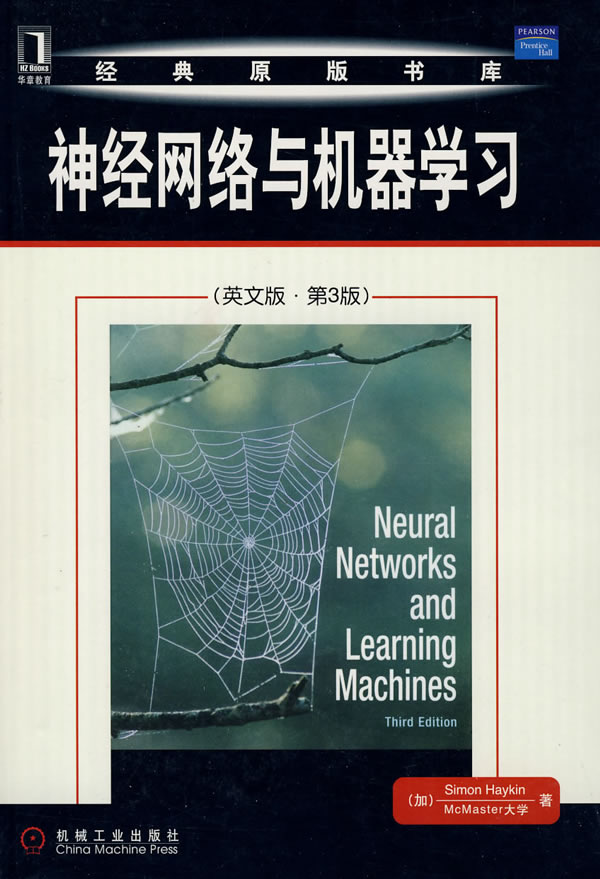
包邮神经网络与机器学习(英文版.第3版)

- ISBN:9787111265283
- 装帧:暂无
- 册数:暂无
- 重量:暂无
- 开本:32开
- 页数:906
- 出版时间:2009-03-01
- 条形码:9787111265283 ; 978-7-111-26528-3
内容简介
神经网络是计算智能和机器学习的重要分支,在诸多领域都取得了很大的成功。在众多神经网络著作中,影响*为广泛的是simon haykin的《神经网络原理》(第4版更名为《神经网络与机器学习》)。在本书中,作者结合近年来神经网络和机器学习的*新进展,从理论和实际应用出发,全面。系统地介绍了神经网络的基本模型、方法和技术,并将神经网络和机器学习有机地结合在一起。
本书不但注重对数学分析方法和理论的探讨,而且也非常关注神经网络在模式识别、信号处理以及控制系统等实际工程问题中的应用。本书的可读性非常强,作者举重若轻地对神经网络的基本模型和主要学习理论进行了深入探讨和分析,通过大量的试验报告、例题和习题来帮助读者更好地学习神经网络。
本版在前一版的基础上进行了广泛修订,提供了神经网络和机器学习这两个越来越重要的学科的*新分析。
本书特色
基于随机梯度下降的在线学习算法;小规模和大规模学习问题。
核方法,包括支持向量机和表达定理。
信息论学习模型,包括连接、独立分量分析(ica),一致独立分量分析和信息瓶颈。
随机动态规划,包括逼近和神经动态规划。
逐次状态估计算法,包括kalman和粒子滤波器。
利用逐次状态估计算法训练递归神经网络。
富有洞察力的面向计算机的试验。
目录
acknowledgements
abbreviations and symbols
glossary
introduction
1 whatis aneuralnetwork?
2 the human brain
3 models of a neuron
4 neural networks viewed as dirccted graphs
5 feedback
6 network architecturns
7 knowledge representation
8 learning processes
9 learninglbks
10 concluding remarks
notes and rcferences
chapter 1 rosenblatt's perceptrou
1.1 introduction
1.2 perceptron
1.3 1he pcrceptron convergence theorem
1.4 relation between the perceptron and bayes classifier for a gaussian environment
1.5 computer experiment:pattern classification
1.6 the batch perceptron algorithm
1.7 summary and discussion
notes and refercnces
problems
chapter 2 model building through regression
2.1 introduction 68
2.2 linear regression model:preliminary considerafions
2.3 maximum a posteriori estimation ofthe parametervector
2.4 relationship between regularized least-squares estimation and map estimation
2.5 computer experiment:pattern classification
2.6 the minimum.description-length principle
2.7 rnite sample—size considerations
2.8 the instrumental,variables method
2 9 summary and discussion
notes and references
problems
chapter 3 the least—mean-square algorithm
3.1 introduction
3.2 filtering structure of the lms algorithm
3.3 unconstrained optimization:a review
3.4 thc wiener fiiter
3.5 ne least.mean.square algorithm
3.6 markov model portraying the deviation of the lms algorithm from the wiener filter
3.7 the langevin equation:characterization ofbrownian motion
3.8 kushner’s direct.averaging method
3.9 statistical lms learning iheory for sinail learning—rate parameter
3.10 computer experiment i:linear ptediction
3.11 computer experiment ii:pattern classification
3.12 virtucs and limitations of the lms aigorithm
3.13 learning.rate annealing schedules
3.14 summary and discussion
notes and refefences
problems
chapter 4 multilayer pereeptrons
4.1 introductlon
4.2 some preliminaries
4.3 batch learning and on.line learning
4.4 the back.propagation algorithm
4 5 xorproblem
4.6 heuristics for making the back—propagation algorithm perfoitn better
4.7 computer experiment:pattern classification
4.8 back propagation and differentiation
4.9 the hessian and lis role 1n on-line learning
4.10 optimal annealing and adaptive control of the learning rate
4.11 generalization
4.12 approximations of functions
4.13 cross.vjlidation
4.14 complexity regularization and network pruning
4.15 virtues and limitations of back-propagation learning
4.16 supervised learning viewed as an optimization problem
4.17 couvolutionai networks
4.18 nonlinear filtering
4.19 small—seale versus large+scale learning problems
4.20 summary and discussion
notes and rcfcreilces
problems
chapter 5 kernel methods and radial-basis function networks
5.1 intreduction
5.2 cover’s theorem on the separability of patterns
5.3 1he interpolation problem
5 4 radial—basis—function networks
5.5 k.mcans clustering
5.6 recursive least-squares estimation of the weight vector
5 7 hybrid learning procedure for rbf networks
5 8 computer experiment:pattern classification
5.9 interpretations of the gaussian hidden units
5.10 kernel regression and its relation to rbf networks
5.11 summary and discussion
notes and references
problems
chapter 6 support vector machines
chapter 7 regularization theory
chapter 8 prindpal-components aaalysis
chapter 9 self-organizing maps
chapter 10 information-theoretic learning models
chapter 11 stochastic methods rooted in statistical mechanics
chapter 12 dynamic programming
chapter 13 neurodynami
作者简介
Simon Haykin,于1953年获得英国伯明翰大学博士学位,目前为加拿大McMaster大学电子与计算机工程系教授、通信研究实验室主任。他是国际电子电气工程界的著名学者,曾获得IEEE McNaughton金奖。他是加拿大皇家学会院士、IEEE会士,在神经网络、通信、自适应滤波器等领域成果颇丰,著有多部标准教材。
-

硅谷之火-人与计算机的未来
¥13.7¥39.8 -

造神:人工智能神话的起源和破除 (精装)
¥32.7¥88.0 -

专业导演教你拍好短视频
¥13.8¥39.9 -

数学之美
¥41.0¥69.0 -

系统性创新手册(管理版)
¥42.6¥119.0 -

计算机网络技术
¥24.1¥33.0 -

Excel函数.公式与图表
¥16.4¥48.0 -

.NET安全攻防指南(下册)
¥89.0¥129.0 -

.NET安全攻防指南(上册)
¥89.0¥129.0 -

人工智能的底层逻辑
¥55.3¥79.0 -

数据挖掘技术与应用
¥52.0¥75.0 -

计算
¥92.2¥128.0 -

MIDJOURNEY AI绘画从入门到精通
¥71.5¥98.0 -

商业产品分析:从用户数据获得商业洞见的数据科学方法
¥89.0¥129.0 -

老年人学电脑
¥34.9¥49.9 -

超简单:用python+ ChatGPT让excel飞起来
¥48.4¥79.0 -

人工智能AI摄影与后期修图从小白到高手:MIDJOURNEY+PHOTOSHOP
¥56.9¥98.0 -

人月神话(纪念典藏版)
¥68.6¥98.0 -

十堂极简人工智能课
¥31.9¥49.0 -

精益数据分析 珍藏版
¥69.5¥119.8














